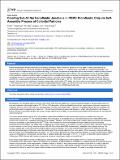Creating Sub-50 Nm Nanofluidic Junctions in PDMS Microfluidic Chip via Self-Assembly Process of Colloidal Particles
Author(s)
Wei, Xi; Syed, Abeer; Mao, Pan; Han, Jongyoon; Song, Yong-Ak
DownloadWei-2016-Creating Sub-50 Nm N.pdf (1.031Mb)
PUBLISHER_POLICY
Publisher Policy
Article is made available in accordance with the publisher's policy and may be subject to US copyright law. Please refer to the publisher's site for terms of use.
Terms of use
Metadata
Show full item recordAbstract
Polydimethylsiloxane (PDMS) is the prevailing building material to make microfluidic devices due to its ease of molding and bonding as well as its transparency. Due to the softness of the PDMS material, however, it is challenging to use PDMS for building nanochannels. The channels tend to collapse easily during plasma bonding. In this paper, we present an evaporation-driven self-assembly method of silica colloidal nanoparticles to create nanofluidic junctions with sub-50 nm pores between two microchannels. The pore size as well as the surface charge of the nanofluidic junction is tunable simply by changing the colloidal silica bead size and surface functionalization outside of the assembled microfluidic device in a vial before the self-assembly process. Using the self-assembly of nanoparticles with a bead size of 300 nm, 500 nm, and 900 nm, it was possible to fabricate a porous membrane with a pore size of ~45 nm, ~75 nm and ~135 nm, respectively. Under electrical potential, this nanoporous membrane initiated ion concentration polarization (ICP) acting as a cation-selective membrane to concentrate DNA by ~1,700 times within 15 min. This non-lithographic nanofabrication process opens up a new opportunity to build a tunable nanofluidic junction for the study of nanoscale transport processes of ions and molecules inside a PDMS microfluidic chip.
Date issued
2016-03Department
Massachusetts Institute of Technology. Department of Biological Engineering; Massachusetts Institute of Technology. Department of Electrical Engineering and Computer ScienceJournal
Journal of Visualized Experiments
Publisher
MyJoVE Corporation
Citation
Xi, Wei, Abeer Syed, Pan Mao, Jongyoon Han, and Yong-Ak Song. "Creating Sub-50 Nm Nanofluidic Junctions in PDMS Microfluidic Chip via Self-Assembly Process of Colloidal Particles." JOVE: Engineering 109: e54145 (2016).
Version: Final published version
ISSN
1940-087X